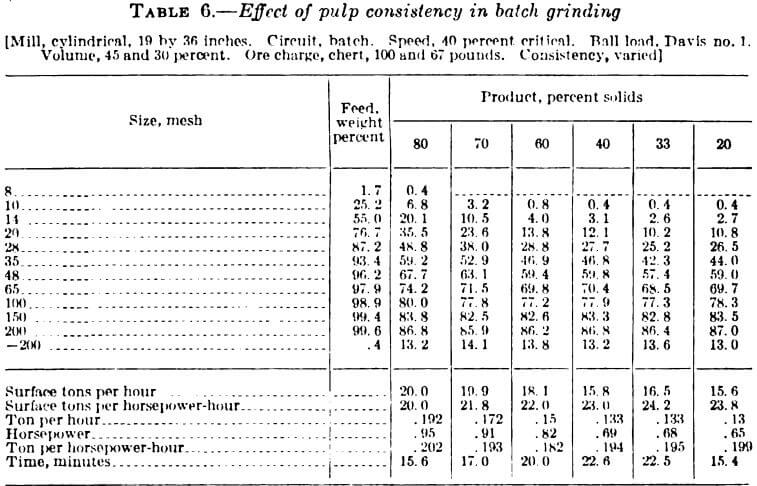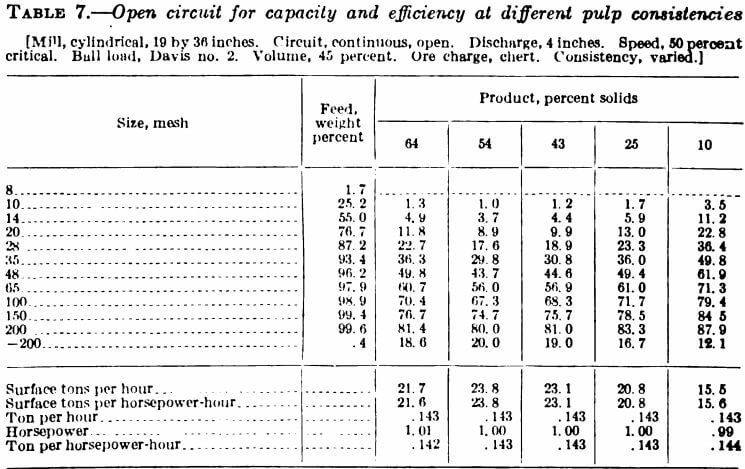Batch Mill Grinding of Ore
Batch grinding affords the best opportunity for first studies of pulp consistency. Table 6 shows some of the results. The consistencies ranged from 80 to 20 percent solids. The initial five tests will be considered first and the last one will be mentioned later. In the last test of the series of five (33 percent solids) so much water was used that the mill was filled.

The thickest pulp required the most power; but it is unsafe to make so broad a generalization. This order would have been reversed at a high speed; for example, if the speed had been on the right side of the high point in the power curve, indicated by the heavy line at the bottom of figure 2 (p. 28), which may be used for illustration, the balls in the thin pulp would have impinged nearer the 8-o’clock position than those in the thick pulp; the balls in the thick pulp would have impinged so high that the results would have been as if the speed were at about 95 percent critical in the above-mentioned figure.
The capacity and power decreased steadily as more water was used. The efficiency, which is the amount of grinding divided by the power, was highest with the thinnest pulp. The thinnest pulp (33 percent solids) was favorable to the best selective grinding, as shown by the cumulated percent weight on 14- or 20-mesh. This is natural because so much water held the fines in suspension and left the coarse particles to be subjected to the ball action in the lower part of the mill. Although the load of water was heavy, its weight was somewhat counterbalanced because the mill was filled.
The last test—the one with 20 percent solids—had to be specially arranged because, as stated, a charge with 33 percent solids filled the mill. To have a pulp as dilute as 20 percent solids, the ball load was drawn down to 30 percent volume and the ore charge proportionately reduced. Water was then added to fill the mill. The results of grinding were much like those with 33 percent solids. All in all, 33 percent solids was the best for efficiency and selective grinding. The selective grinding was far, better than in the case of the 80 percent pulp; with 33 percent solids, only 10.2 percent of the ore remained on 20 mesh, whereas with 80 percent solids 35.5 percent was on the same screen. As some operators prefer a thick pulp, the additional capacity gained by the thick pulp warrants consideration. When they have found that the capacity is best with a thick pulp, they may obtain the same advantage with a dilute pulp by increasing the speed of the mill. Finally, the best efficiency and selective grinding was at 33 percent solids. Of course, so much water could not be held in the mill when the circuit was open.
Open Circuit Grinding
The effect of pulp consistency may be examined further in table 7 which shows open-circuit grinding. The pulp consistencies of the feed ranged from 10 to 64 percent solids. A thicker pulp could not be handled by the feed scoop. The horsepower was about the same in each test, and since the feed rate was always the same the number of tons per horsepower-hour was a constant throughout. Having established this constant, the diagnosis may be made quickly without surface calculations. In fact, surface calculations make a rather rough criterion when there is so much difference in the amount of the minus 200-mesh size as is shown in table 7. However, there is no doubt that in accordance with the calculations the best capacity and efficiency occurred with 54 percent solids, and an impartial examination will show that the selective grinding was about the same throughout.
An ore of different particle size would have required a different pulp consistency for best work.
Tables 6 and 7 cannot be compared advantageously because ball loads and speeds were not the same.
In a former paper, under the erroneous caption “Pulp Density” (it should have been “Pulp Consistency”), the question was asked whether the consistency in the mill was the same as in the effluent. What follows here purports to answer that question:

In table 6 it was shown that the batch mill could hold only enough water to reduce the pulp consistency to 33 percent. What, then, was the condition in the mill with a continuous feed and discharge as dilute as 10 percent solids, and was the pulp in the mill of the same consistency as the effluent?
These questions are answered: When the feed was very dilute a part of the ore was sluiced out of the mill and replaced by water, so that the percentage of solids in the mill was about the same as the feed and effluent. The mill with 10 percent solids contained only 17 pounds of ore, whereas with a normal pulp it would have contained 75 or 100 pounds. By these tests the pulp consistency in the mill in continuous work seems to be the same as the effluent.
